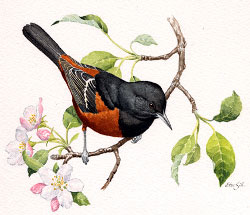Find a Bird - BBA1
Breeding Bird Atlas 1 Species Accounts
Orchard Oriole
Icterus spurius
Egg Dates
May 28 to June 25
Number of Broods
one

The Orchard Oriole is an uncommon and local summer resident in the state, where it is near the northern limit of its breeding range. Most breeding records are from coastal regions and interior river valleys because Orchard Orioles are rare or lacking in areas of higher elevations. Once this species has nested at a locality, it often returns in subsequent years, and small “colonies” consisting of several pairs may become established. Such is the case at the Heard’s Pond area of Wayland, where it has nested almost annually since 1887. The distribution in Massachusetts apparently has changed little during the historical period, but the number of nesting pairs has increased since about 1960.
Migrants are seldom encountered in either spring or fall, although coastal storms of southerly origin in mid- or late April will sometimes bring individuals to southeastern coastal areas before their expected arrival. Resident males usually appear during the first week of May, at the same time or slightly before the Northern Oriole. In marked contrast to the chestnut and black older males, the first-year males resemble the yellow-olive females but have a black throat. These young males may be “floaters,” wandering over a large area during May and early June in search of a mate, and, although they have been observed helping established pairs feed young, they are also capable of mating and breeding successfully. It appears that older males establish their territories fairly quickly. Orchard Orioles usually nest in rural areas but increasingly are being found in suburban residential areas; common to both is the presence of water, usually a stream or pond. Relatively open areas with trees occurring in clumps are especially favored, and dense woodlands are avoided.
The song, a quick series of varied whistled notes, is likened to those of House and Purple finches and is often the best clue to the presence of an Orchard Oriole because the birds are very retiring in nature. The call note is a low check. The nest, constructed solely by the female, is composed of green grasses of various lengths. It is usually placed in the fork of a horizontal limb and, until the components turn brown, is nearly invisible in the foliage of the nest tree. Although most early references note this oriole’s preference for building in deciduous trees, a larger percentage of local nests have been located in conifers, especially Pitch Pine. A nest in Berkley was hidden among leaves in an apple tree 15 feet above the ground (ACB). In Massachusetts, nest building generally occurs in late May.
The clutch size varies from three to seven (typically four or five) eggs, and the female incubates for 12 to 14 days. When the young hatch, typically in mid-June, both parents share the feeding duties. The young remain in the nest 11 to 14 days, fledging in late June or early July in Massachusetts. Nestlings have been reported in the state from June 23 to July 15. Single adults or pairs were observed feeding one fledgling (2 records), two fledglings (1 record), three fledglings (1 record), and four fledglings (2 records) (ACB, BOEM, TC).
Once nesting is completed, Orchard Orioles become inconspicuous. Departure from the area commences in July and continues during August; only stragglers are reported after this time. The bulk of the population winters in Central America, where the birds gather nightly in large communal roosts.
Map Legend and Data Summary
Atlas 1 data collected from 1975-1979


Note: very uncommon and local in open wooded areas, often near water; most common in eastern Massachusetts
Richard A. Forster



